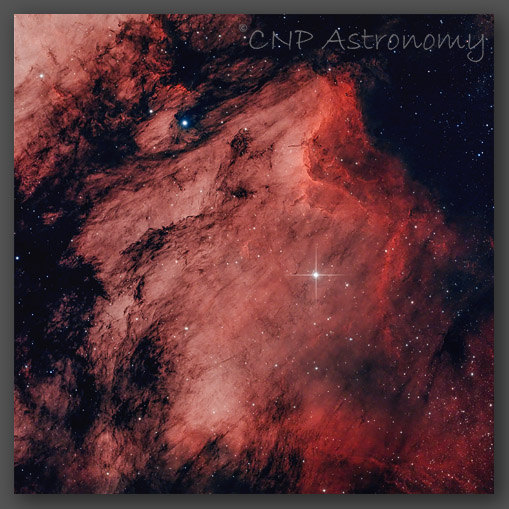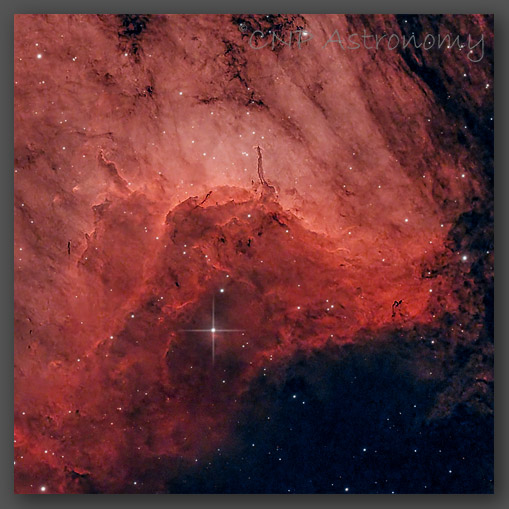230717 IC5067 "Pelican" nebula
|
Mouse-over either image to see Hubble Palette
("Sulphur-Hydrogen-Oxygen");
|
ASTRO:
type=Emission nebula mag=8.0 const=Cygnus dist=1800 ly size=31 ly IMAGE: location=EB Driveway BrtlCls=5 moon=0%, (new) exposure=CMOS OSC; 59x300s (4.9h), G105 EQUIPMENT: camera=ZWO ASI2600MC-Pro optics=ES102 w0.8x rdcr, FL=571mm, f/5.6 filter=Optolong L-eXtreme Duo NB mount=Celestron AVX guiding=Orion 60x240mm wZWO ASI224MC SOFTWARE: acquisition=Stellarium, APT, PHD2, processing=PixInsight, RCAstro, PhotoshopCC, LrC |
The Pelican Nebula (also known as IC 5067) is an H-II region associated with the North America Nebula in the constellation Cygnus. The gaseous contortions of this nebula bear a resemblance to a pelican, giving rise to its name. It is located nearby first magnitude star Deneb, and is divided from its more prominent neighbor, the North America Nebula, by a foreground molecular cloud filled with dark dust. Both are part of the larger H-II region called, Westerhout 40.
The Pelican is extensively studied because it has a particularly active mix of star formation and evolving gas clouds. In these images, the nebula's main ionization front is showcased through careful cropping and framing of the subject target. The light from young energetic stars can be seen slowly transforming clouds of gas from cold (dark) to hot (energetic and light), causing this ionization front to gradually advance outward. Millions of years from now this nebula might no longer be known as the Pelican, as the balance and placement of stars and gas will be in different spatial positions; thus, the nebula likely will appear completely differently from how it does today.
The Pelican Nebula rests at a transition point in terms of difficulty for capture of a photographic image. It is a faint object with varied and diverse optical detail, making it an immensely popular target for amateur imagers aspiring to master their craft.
THE HUBBLE PALETTE
The professional astronomical teams at NASA and ESA associated with the Hubble Space Telescope have developed a new way to improve contrast in deep-space images using a color palette that is different from the traditional red-green-blue ("RGB") palette commonly used in "every-day" broad-band photographs. More specifically known as the "Sulphur-Hydrogen-Oxygen" technique ("SHO" for short, or the "Hubble Palette"), this new color combination is particularly applicable to images of emission nebulae. The resulting false-color skyscapes are intended to improve visual contrast within the hot glow of emissions from atomic ionized gas by making the light from different gasses show-up in different colors; thus, making details within nebulae more visible. It just so happens SHO images are also seen as being just as beautiful and tantalizing as they are scientifically useful.
In the images above, the process entailed gathering data with a one-shot-color ("OSC") camera fitted with a dual narrow-band ("DNB") filter during collection of the sub-exposures. The specific DNB filter used had band-pass capabilities (meaning, the filter allowed certain colors to pass-through to the camera sensor) in the hydrogen-alpha ("Ha") and oxygen3 ("OIII"") wavelengths (colors) of light. These wavelengths are very specific to emission nebulae. The filter suppressed (or blocked) all the rest of the colors of visible light from reaching the camera sensor, including those commonly associated with light pollution caused by nearby city streetlights. The resulting images were then processed by "color mapping" (mixing) the passed wavelengths in software to the traditional red, green and blue channels in a very specific way to produce these beautiful and stunning golden-blue hues.
In appx 1995 NASA publicly released information on the SHO photographic technique documenting how to apply it, and how to create SHO images. Since then, it has become an extremely popular 'main-stay' among amateur astro-imagers world-wide. Through experimentation, amateurs have also developed several variations on the SHO theme, including one that has also become very popular - being the "SOO" palette (for Sulphur-Oxygen-Oxygen). While not shown here, the results of applying the SOO palette may be viewed in other images in the CNP_Astronomy collection including 230808 WR134 "Cygnus Ring" nebula, and 230813 - Sh2-162 "Bubble" nebula.
The Pelican is extensively studied because it has a particularly active mix of star formation and evolving gas clouds. In these images, the nebula's main ionization front is showcased through careful cropping and framing of the subject target. The light from young energetic stars can be seen slowly transforming clouds of gas from cold (dark) to hot (energetic and light), causing this ionization front to gradually advance outward. Millions of years from now this nebula might no longer be known as the Pelican, as the balance and placement of stars and gas will be in different spatial positions; thus, the nebula likely will appear completely differently from how it does today.
The Pelican Nebula rests at a transition point in terms of difficulty for capture of a photographic image. It is a faint object with varied and diverse optical detail, making it an immensely popular target for amateur imagers aspiring to master their craft.
THE HUBBLE PALETTE
The professional astronomical teams at NASA and ESA associated with the Hubble Space Telescope have developed a new way to improve contrast in deep-space images using a color palette that is different from the traditional red-green-blue ("RGB") palette commonly used in "every-day" broad-band photographs. More specifically known as the "Sulphur-Hydrogen-Oxygen" technique ("SHO" for short, or the "Hubble Palette"), this new color combination is particularly applicable to images of emission nebulae. The resulting false-color skyscapes are intended to improve visual contrast within the hot glow of emissions from atomic ionized gas by making the light from different gasses show-up in different colors; thus, making details within nebulae more visible. It just so happens SHO images are also seen as being just as beautiful and tantalizing as they are scientifically useful.
In the images above, the process entailed gathering data with a one-shot-color ("OSC") camera fitted with a dual narrow-band ("DNB") filter during collection of the sub-exposures. The specific DNB filter used had band-pass capabilities (meaning, the filter allowed certain colors to pass-through to the camera sensor) in the hydrogen-alpha ("Ha") and oxygen3 ("OIII"") wavelengths (colors) of light. These wavelengths are very specific to emission nebulae. The filter suppressed (or blocked) all the rest of the colors of visible light from reaching the camera sensor, including those commonly associated with light pollution caused by nearby city streetlights. The resulting images were then processed by "color mapping" (mixing) the passed wavelengths in software to the traditional red, green and blue channels in a very specific way to produce these beautiful and stunning golden-blue hues.
In appx 1995 NASA publicly released information on the SHO photographic technique documenting how to apply it, and how to create SHO images. Since then, it has become an extremely popular 'main-stay' among amateur astro-imagers world-wide. Through experimentation, amateurs have also developed several variations on the SHO theme, including one that has also become very popular - being the "SOO" palette (for Sulphur-Oxygen-Oxygen). While not shown here, the results of applying the SOO palette may be viewed in other images in the CNP_Astronomy collection including 230808 WR134 "Cygnus Ring" nebula, and 230813 - Sh2-162 "Bubble" nebula.



